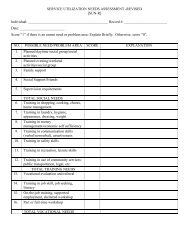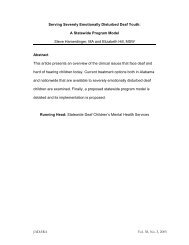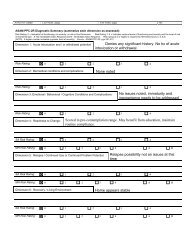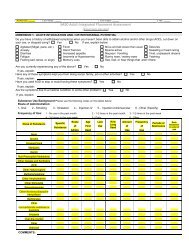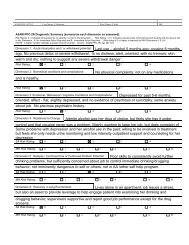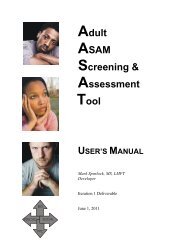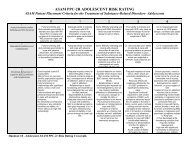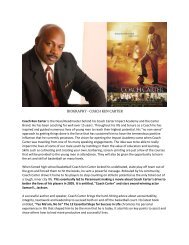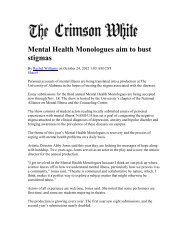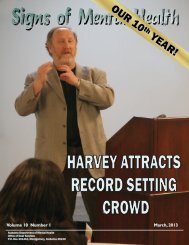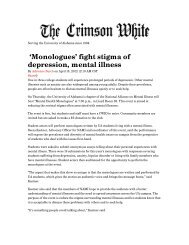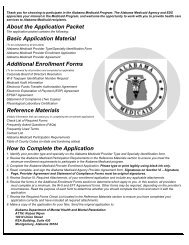Volume 8 Number 4 December, 2011 - Alabama Department of ...
Volume 8 Number 4 December, 2011 - Alabama Department of ...
Volume 8 Number 4 December, 2011 - Alabama Department of ...
You also want an ePaper? Increase the reach of your titles
YUMPU automatically turns print PDFs into web optimized ePapers that Google loves.
New Year Brings Big Changes<br />
in Deaf Services<br />
There are big changes in services to Deaf Alabamians with<br />
mental illness coming in 2012. These changes were<br />
announced by Deaf Services Director Steve Hamerdinger at<br />
the Office <strong>of</strong> Deaf Services Advisory Group meeting in Montgomery<br />
<strong>Alabama</strong> on November 17, <strong>2011</strong>.<br />
For a long time there has been a steady shrinking in linguistically<br />
appropriate services to deaf people. At one time there<br />
were four regional <strong>of</strong>fices, each with a counselor. By the<br />
beginning <strong>of</strong> <strong>2011</strong>, there was only one deaf therapist left.<br />
There were, at one time, as many as 15 slots in community<br />
residential programs serving deaf people specifically. Today,<br />
there are only nine.<br />
One devastating impact <strong>of</strong> this steady downsizing was felt at<br />
the Bailey Deaf Unit. Before, it was a program that was led by<br />
deaf people, staffed by deaf people, where deaf people<br />
received services that were “Deaf-friendly.” Over time, many<br />
<strong>of</strong> the deaf pr<strong>of</strong>essional level positions in the program were<br />
lost to “downsizing.”<br />
Worse than that, people who had mental illness and were<br />
admitted to BDU increasingly found themselves with no place<br />
to go when they were ready to leave. The loss <strong>of</strong> services in<br />
the community meant that deaf people increasingly were<br />
“stuck” in a program that was never meant to be long term.<br />
BDU was becoming more and more “hearing” at the same<br />
time deaf people were staying longer and longer.<br />
<strong>Department</strong> <strong>of</strong> Mental Health Commissioner Zelia Baugh and<br />
Associate Commissioner for Mental Health and Substance<br />
Abuse, Tammy Peacock, wanted to change this trend. Dr.<br />
Peacock asked Hamerdinger, “What would it take to make<br />
things better” From that initial discussion a new plan was<br />
developed.<br />
The new plan, which is loosely based on the transformation<br />
<strong>of</strong> services that happened in South Carolina over the past<br />
decade, will shift focus from in-patient services, which is a<br />
medical model, to community services focusing on recovery,<br />
and is more “person-centered.”<br />
The Bailey Deaf Unit is scheduled to cease operation in Montgomery<br />
in the spring, and new programs will open around the<br />
state to take its place Hamerdinger announced.<br />
A six-bed Deaf Recovery Program will open in Tuscaloosa,<br />
where deaf people who have been in the hospital will be able<br />
to work on skills they need to succeed in the community. The<br />
new program will be located on property <strong>of</strong> the old Partlow<br />
Developmental Center, which is now closed. There are a<br />
number <strong>of</strong> cottages on the property which are easily<br />
adaptable to the needs <strong>of</strong> the program. In addition, the DRP,<br />
slated to be housed in Cottage 9, will be a stone’s throw from<br />
the new psychiatric hospital that will replace Bryce and is<br />
now under construction.<br />
(Continued on page 12)



